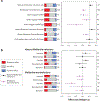Evolutionary Ecology of Wolbachia Releases for Disease Control
- PMID: 31505135
- PMCID: PMC6944334
- DOI: 10.1146/annurev-genet-112618-043609
Evolutionary Ecology of Wolbachia Releases for Disease Control
Abstract
Wolbachia is an endosymbiotic Alphaproteobacteria that can suppress insect-borne diseases through decreasing host virus transmission (population replacement) or through decreasing host population density (population suppression). We contrast natural Wolbachia infections in insect populations with Wolbachia transinfections in mosquitoes to gain insights into factors potentially affecting the long-term success of Wolbachia releases. Natural Wolbachia infections can spread rapidly, whereas the slow spread of transinfections is governed by deleterious effects on host fitness and demographic factors. Cytoplasmic incompatibility (CI) generated by Wolbachia is central to both population replacement and suppression programs, but CI in nature can be variable and evolve, as can Wolbachia fitness effects and virus blocking. Wolbachia spread is also influenced by environmental factors that decrease Wolbachia titer and reduce maternal Wolbachia transmission frequency. More information is needed on the interactions between Wolbachia and host nuclear/mitochondrial genomes, the interaction between invasion success and local ecological factors, and the long-term stability of Wolbachia-mediated virus blocking.
Keywords: biocontrol; dengue; fitness costs; transinfections; vector replacement; vector suppression.
Figures


References
-
- Ahantarig A, Trinachartvanit W, Kittayapong P. 2008. Relative Wolbachia density of field-collected Aedes albopictus mosquitoes in Thailand. J. Vector Ecol 33:173–77 - PubMed

